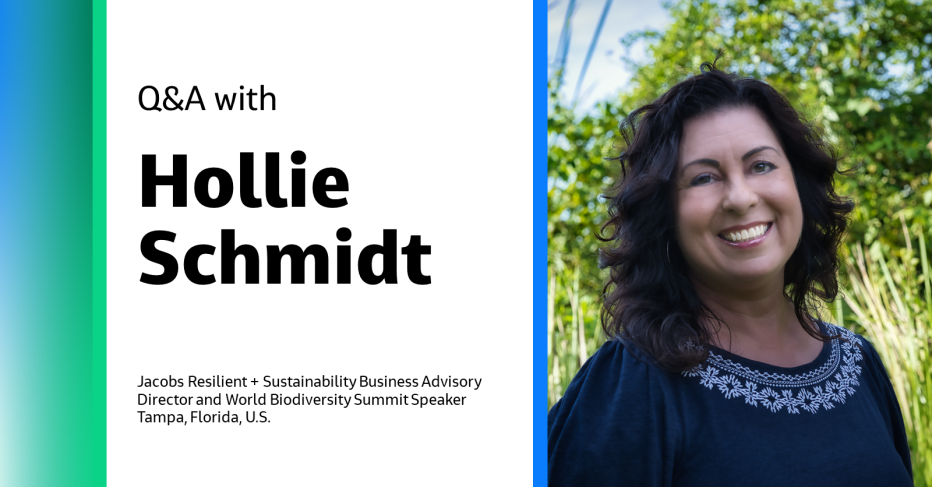
While the song “We are the World” may have been released in 1985, the message it holds still rings true today. Decades later, resilience, sustainability, climate action and biodiversity are all trending topics, leading to a transformation in how we develop and treat our planet. This transformation is one of the many things Jacobs Resilient + Sustainability Business Advisory Director Hollie Schmidt will address in her talk at the World Biodiversity Summit in New York City as part of Climate Week NYC. We sat with Hollie to discuss her thoughts on biodiversity and the challenges and opportunities we face in developing a sustainable future.
Tell us a bit about your career background and your role at Jacobs.
I joined Jacobs in 2000, five years into my career, and have spent more than 22 years as part of our Advanced Planning Group (APG). APG is small, but a true example of the consulting and advisory services we can provide clients. We’re probably one of the best-kept secrets at Jacobs, focusing on larger-scale, multi-disciplinary predesign services. A lot of my duties include feasibility studies, business cases, master and strategic planning and site selection.
For example, when Hurricane Michael hit Tyndall Air Force Base, I spent 18 months on that program working across all the technical disciplines related to the natural and built environments to deliver design guidance for the rebuild. We worked with the client to bring sustainable, resilient, and smart solutions to the base, transforming it into an Installation of the Future. That experience was incredibly transformative in my career and has led to a lot of momentum across the company for these types of efforts.
I’ve enjoyed being a strategic advisor and delivering solutions that can bring our clients and businesses to the next level regarding sustainability, resilience and climate action.
Congratulations on being selected as a speaker at the World Biodiversity Summit. What makes you excited about this opportunity?
Well, I think we are in the middle of a massive sustainable transformation as it relates to how we develop our planet. Due to the COVID-19 pandemic, clients and companies look differently at the way they operate — they were forced to work in a dramatically different way and the positive aspects of that behavior can be get pushed forward. There is a lot of investment in climate action, and it's exciting to be a part of it. Companies are making public commitments to address climate action and ESG (environmental, social and governance). The financial markets are pivoting. So, there's just this real wave of collective pressure to do things differently.
Alongside that, with increasing and preserving biodiversity as a goal, we can look at how we have traditionally developed and refocus on redeveloping land versus building on new, greenfield, sites. Then as we develop, we need to ask ourselves, how do we reintroduce biodiversity into our solutions? We must harmoniously live with nature. We can't just take nature out of the equation because then we lose all the ecosystem services that nature provides, such as clean air, carbon sinks, health and wellness and fresh water. I’m excited to hear more about what is happening globally in this space and be the ambassador for Jacobs.
What is the philosophy behind this transformation?
It's really a transformation in how we develop and treat the planet. We need to think about two things — resilience and sustainability.
With resilience, we must be more robust against the acute shocks and enduring stressors that come from our natural environments, such as natural disasters and climate change. We need to think about those factors when we are developing infrastructure. We can create things that stand up to our planet and positively impact it for the future from a physical, human and business environment. From the business perspective, we need to consider not only the physical aspects of how we develop but aspects of supply chain issues and how a healthy economy leads to healthy communities.
With sustainability, it’s about our impact on the environment and how we can be more efficient. So, consider how we design our spaces and incorporate biodiversity into those solutions. Instead of just building a roadway, we're building streets with nature-based infrastructure for stormwater management.
Resilience and sustainability are really two sides of the same coin — being strong and tough against shocks and stressors, but also being sustainable and beyond net zero in the way that we develop and infuse biodiversity — meaning, let's reintroduce nature into our solutions.
“You would never think that nature can help our national security, but that's what we're doing, and it's been great.”
What does biodiversity mean to you?
Biodiversity is increasing the presence and variety of our biological environments, habitats and ecosystems and reestablishing nature as a foundational component of how we develop. To do this we should avoid building things that don't have any natural environment components and build things that add value to the natural environment and are regenerative. Things like green roofs on buildings that incorporate vegetation and natural landscapes into their design, nature-based solutions for stormwater management and tree canopies for shade and heat mitigation.
When I look at how to incorporate biodiversity, I think to myself, ok, how do we pick sites for our clients that won't have a tremendous negative impact if they're redeveloped and can have positive performance? And how do we develop them in a way that preserves or reestablishes the natural environment as much as possible? For example, for a coastal environment, we can build a seawall, or we can replicate the coastal environment that was there before you developed it. Both can yield resilience for holding water back or tempering down the water energy, but the nature-based solution encourages habitats. Utilizing nature-based solutions is more dynamic and enduring because once you reestablish the natural state, it takes care of itself. So, there's a long-term business case that's very compelling to bring nature back into our solutions. That’s what biodiversity means to me.
Can you share an example of how we are supporting clients in their biodiversity efforts?
The Tyndall story is compelling, and I think one of the most significant opportunities I've ever had in my career to apply nature-based solutions. We started with looking at how we treat stormwater and a way that is different from putting in, you know, stormwater pipes and gutters along our parking lots and roadways. The program looked at land management and partnering with outside stakeholders to improve the base for the future.
Because of this effort, we now work with the Engineering with Nature Program to integrate engineering with nature solutions across Department of Defense installations. I now work across 12 different installations within three different geographies. It's just been fascinating to see where we have mission-critical infrastructure and how nature can fix that. How can reestablishing and restoring the natural state help with our mission assurance? You would never think that nature can help our national security, but that's what we're doing, and it's been great.
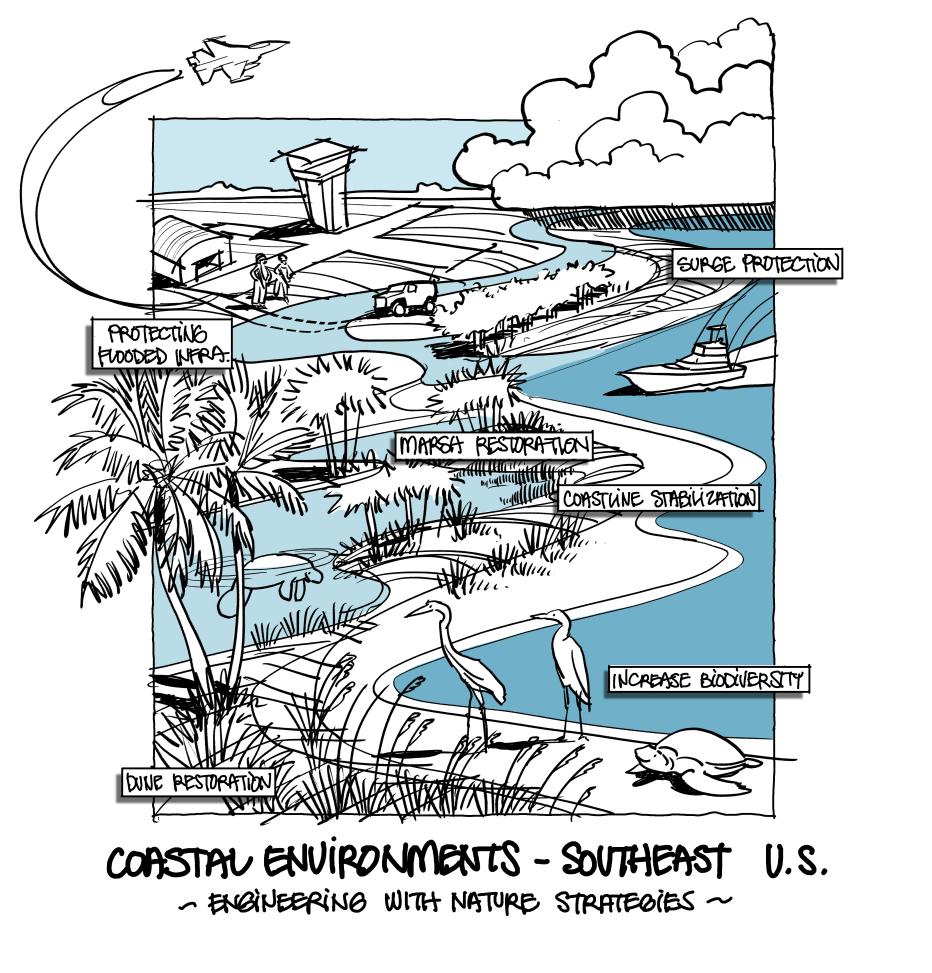
What challenges and opportunities do we face as an organization with biodiversity?
I think the challenges that Jacobs faces regarding biodiversity are the same challenges that our clients face. Biodiversity is a subset of resilient, sustainable and climate action-oriented solutions. Many companies are making public commitments but delivering on those commitments is essential. That is the real challenge. Culturally, we all must think differently about our solutions and go beyond a business-as-usual approach. It isn't easy to transform a 55,000-person solutions provider into thinking about biodiversity. Pipes and metal may be a viable option but instead, let's pick the more sustainable and resilient solution that is also just as viable and may even have more positive long-term effects.
This is the same challenge our clients have. They’re setting net-zero commitments, but what does that mean for their projects? How much does it cost to use these solutions? That's where we come in. There's a business case to say these are viable solutions. They have a compelling bottom line and return on investment, and they're more sustainable for the future. There may be a slightly higher front-end investment but the long-term, lifecycle paybacks and benefits are significant. We, as Jacobs, can be a leader in this space. I would like to see us thinking resiliently and sustainably across every market and asking ourselves, how can we do things differently? It's transforming how we deliver business, and our clients are going through the same thing.
As individuals, what is one thing we can do to combat biodiversity loss?
We all have our footprints in our lives. I live in Florida and have tried to eliminate as much grass as possible so that I'm not mowing and creating something that is high maintenance. I'm integrating native plants into my yard, attracting pollinators and wildlife that would naturally be here if I hadn't developed this property into my home. I think one aspect of what we can do at home is thinking about how we can attract nature back into our homesteads. How can we re-naturalize the land that we are stewards of ourselves?
Another aspect is that we can engage with and support organizations trying to conserve, preserve and restore our natural environment. We have a lot of influence in our communities, and we can encourage the people around us to get involved. Jacobs has a large platform in this aspect, which we can use to promote biodiversity and biodiversity solutions.
“We all have our footprints in our lives. I live in Florida and have tried to eliminate as much grass as possible so that I'm not mowing and creating something high maintenance. I'm integrating native plants into my yard, attracting pollinators and wildlife that would naturally be here if I hadn't developed this property into my home. I think one aspect of what we can do at home is thinking about how we can attract nature back into our homesteads.”
What excites you about the future of this area of study?
It's become evident that we cannot continue the way that we've been developing our planet. It's in plain daylight. Every day we see intensive flooding, wildfires and droughts drying up our rivers — it's time we take a different approach. What excites me is that I can take the influence that I have to do better. I feel like I'm making a positive impact one project at a time. When you get these large-scale projects like a Tyndall Air Force Base rebuild, you can significantly influence and shape those environments to make the base even better than before, not only for the environment around the base but also for the service members, their families and the civilians working there. I get excited thinking about how I can make that positive impact one effort at a time.
What advice do you have for those looking to get involved in biodiversity efforts?
I think the key to being a biodiversity champion is to understand what biodiversity is in the area you want to influence, so that comes down to the nature of the place. What did that place look like before? What native habitats and species existed before man pushed them out of their space? And how can you reestablish that in small ways?
It makes me think about when my kids were little. They're teenagers now, but they feared bees. And I would tell them, don't fear bees. Bees do amazing things for us. They're pollinators. Once I explained to them what a pollinator does and its importance, it completely changed how they thought about bees. Now, if we're swimming in our pool, and a bee is in the pool, I see my kids take the skimmer and pull it out so it can fly away instead of killing it. I think it's all about educating ourselves on the services nature provides.
What do you enjoy most about being part of #OurJacobs?
I enjoy working horizontally across our company. I work across all markets and all geographies, so I’m learning something new daily. I love getting this extreme, diverse exposure to all these client and project types.
I also love working across disciplines. Whether working with environmental scientists or architects and interior designers, I learn from them. I feel like I'm living this continuing education all the time, and it's helping me be the best generalist I can be. I'm not a wastewater treatment specialist, but I understand how wastewater treatment fits into the bigger picture. So really being able to listen to a client with a complex set of issues and bringing the right technical specialists to give them the best solution. I think that differentiates us from what you would see at typical managerial consulting services because we have that massive technical bench that can advise us in the predesign space.
About the interviewee
Hollie Schmidt is the Director of the Resilient + Sustainability Business Advisory at Jacobs. She served as the lead for nature-based solutions at Tyndall Air Force Base in Florida, following Hurricane Michael, to drive the rebuild to be more resilient, sustainable and smart. Hollie was a core team member for stakeholder engagement and outreach, program delivery, and multi-disciplinary coordination. She led the infrastructure technical team comprising all disciplines for wet/dry utilities, transportation/mobility, landscape and site layout, nature-based infrastructure, MEP, environmental, architecture, sustainability, resiliency, and SMART systems. She was also involved in updating the landscape master plan and coastal resilience strategy and closely coordinated with the USACE Engineering Research and Development Center’s (ERDC) Engineering With Nature (EWN) program. https://ewn.erdc.dren.mil/
Watch the recording of Hollie's panel from the World Biodiversity Summit here.
You might be interested in...
-
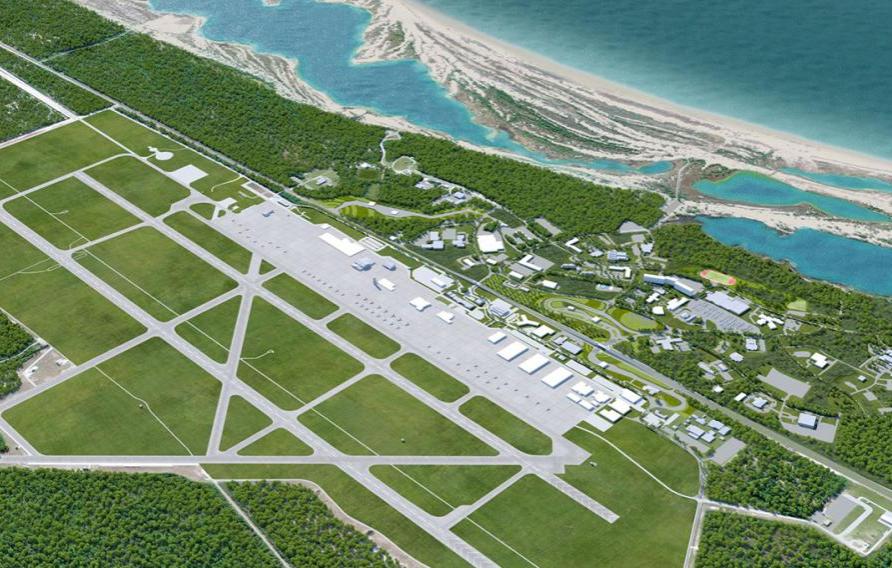 Showcase
ShowcaseTyndall Air Force Base, Panama City Beach, Florida
In October 2018, Tyndall Air Force Base (AFB) was hit with a Category 5 hurricane which resulted in damage to 100% of its assets. As a result, they have embarked on a rebuilding program that is focused on creating a resilient, sustainable and smart Installation of the Future that leverages innovative solutions in a “system of systems” approach to perform at the nexus of mission assurance, cost efficiency, and social and environmental sustainability.
-
 News
NewsBridging the Gap Between Decarbonization, Net Zero through Nature-based Solutions
Net zero requires action in two directions. On the one side, organizations must work to significantly reduce the release of emissions. On the other, they must support the removal of continued emissions from the atmosphere once decarbonization measures have been implemented. Nature-based solutions – also known as natural climate solutions - have a significant role to play in achieving net zero, spanning both emission reductions and removals.
-
 News
NewsJacobs and The Nature Conservancy Partner to Restore Oyster Reefs Along the Gulf Coast
Sharing a passion for natural infrastructure as a viable way to increase coastal and climate change resilience, The Nature Conservancy and Jacobs collaborate on the Pensacola East Bay Oyster Habitat Restoration Project.
-
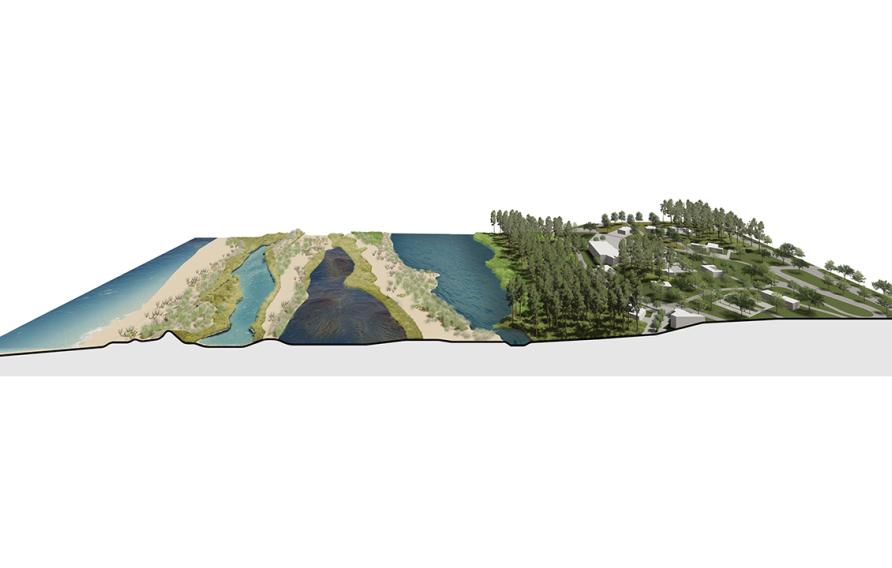 News
NewsTyndall Air Force Base: Coastal Resilience in Support of Mission Assurance and Becoming the Installation of the Future
A significant component of ensuring the future resilience of the base is addressing the risks that arise from coastal flooding and erosion. As part of the approach, our Tyndall AFB Rebuild Team is exploring a series of pilot projects that use nature-based solutions to reduce coastal flood risks while creating important social and environmental benefits.
-
 News
NewsJacobs Receives Excellence Award for Tyndall AFB Coastal Resiliency Program
Jacobs has received the International Excellence Award from the United Kingdom's Environment Agency Flood & Coast Excellence Awards for the Coastal Resilience Program at Tyndall Air Force Base in Florida.
-
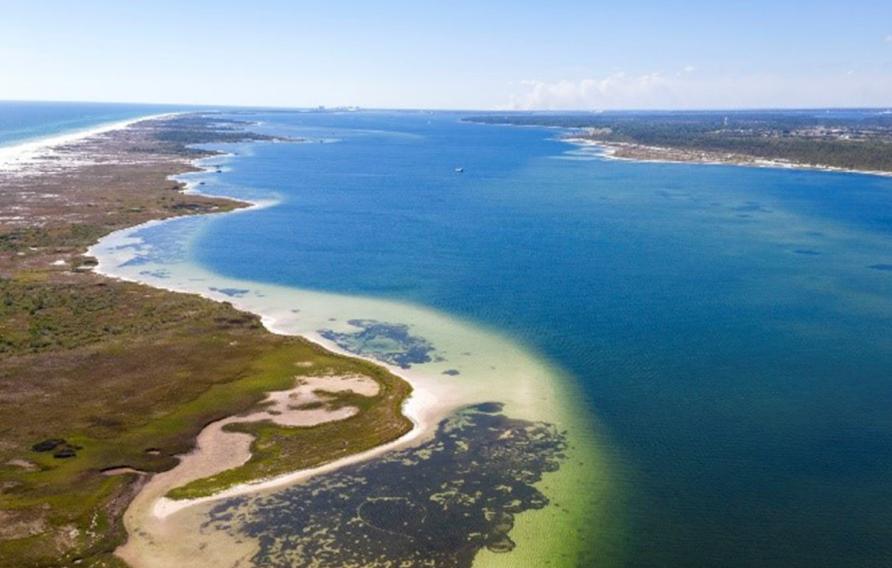 News
NewsFrom Seashells to Sand Dollars: Finding Funding for the Tyndall Coastal Resiliency Program
Dr. John Mogge, Jacobs’ Director of Federal Solutions & Technology, and Lieutenant Colonel Brandy Smart, Commander of the 325th Civil Engineer Squadron, talk about Tyndall Air Force Base, coastal resiliency and alternative funding.
Join #OurJacobs team
What drives you drives us as we work to build a better world – together. At Jacobs, every day is an opportunity to make the world better, more connected, more sustainable. We’re always looking for dynamic and engaged people to join our team. Bring your passion, your ingenuity and your vision.













































